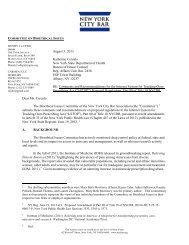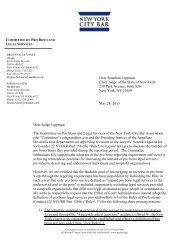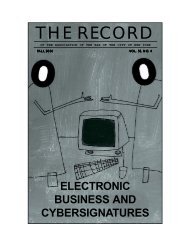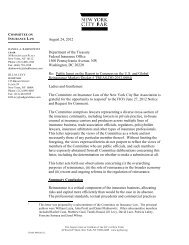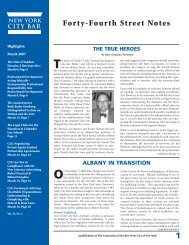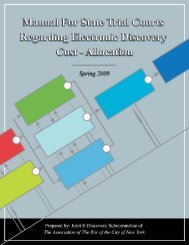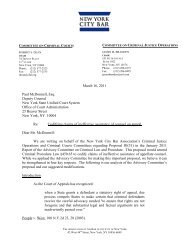2007 Issue 1 - New York City Bar Association
2007 Issue 1 - New York City Bar Association
2007 Issue 1 - New York City Bar Association
Create successful ePaper yourself
Turn your PDF publications into a flip-book with our unique Google optimized e-Paper software.
J U D I C I A L S E L E C T I O N T A S K F O R C E<br />
many state constitutions to reflect that value. In 1832, in what Learned<br />
Hand called “a burst of democratic enthusiasm,” 12 Mississippi became<br />
the first state to establish an entirely elective judiciary. <strong>New</strong> <strong>York</strong> followed<br />
suit in 1846, and many states promptly followed soon thereafter. Every<br />
state that joined the Union between 1846 and 1958 adopted constitutions<br />
that provided for elective judiciaries. During the same period,<br />
Michigan (1850), Pennsylvania (1850), Virginia (1850) and Maryland<br />
(1851) all amended their constitutions to provide for the election of some<br />
or all of their judges. 13 By the time of the Civil War, 22 of 34 states elected<br />
their judges. 14<br />
For 160 years, justices of the State Supreme Court—<strong>New</strong> <strong>York</strong>’s trial<br />
court of general jurisdiction—have been elected by popular vote. That<br />
selection method has been dictated since 1846 by the State Constitution,<br />
which provides: “The justices of the supreme court shall be chosen by the<br />
electors of the judicial district in which they are to serve.” N.Y. Const.<br />
art.VI, § 6(c). Judges of other State courts of record are also chosen by<br />
election, including judges of the County, <strong>City</strong>, District and Surrogate’s<br />
Courts; <strong>New</strong> <strong>York</strong> <strong>City</strong>’s Civil Court; and (outside of <strong>New</strong> <strong>York</strong> <strong>City</strong>) the<br />
Family Court.<br />
It was not long, however, before a backlash set in. Two factors motivated<br />
that change. First, political parties quickly attained effective control<br />
over the election of judicial candidates and the retention of judges in<br />
partisan elections. One historian observed that the history of early judicial<br />
elections “worked out as a de facto system of appointment.” 15 Indeed,<br />
in language penned in 1928—but which might, were it not for a reference<br />
to the <strong>City</strong> of Chicago, understandably be confused for a passage in Lopez<br />
Torres—a law professor at Northwestern University wrote:<br />
It is one of our most absurd bits of political hypocrisy that we<br />
12. Learned Hand, supra note 10, at 88.<br />
13. See Steven P. Croley, The Majoritarian Difficulty: Elective Judiciaries and the Rule of Law,<br />
62 U. CHI. L. REV. 689, 716-17 (1995). After reviewing the debate at <strong>New</strong> <strong>York</strong>’s Constitutional<br />
Convention of 1846, Croley concludes: “An elective judiciary was defended by its<br />
supporters not so much on the grounds that it advanced fundamental principles of constitutional<br />
democracy, as on the grounds that giving judicial selection to the people directly would<br />
avoid certain ills that alternative selection systems had brought.” Id. at 721.<br />
14. Jona Goldschmidt, Merit Selection: Current Status, Procedures, and <strong>Issue</strong>s, 49 U. MIAMI L.<br />
REV. 1, 5 (1994).<br />
15. James W. Hurst, The Growth of American Law: the Law Makers 133 (1950), quoted in<br />
Goldschmidt, supra note 14, at 6.<br />
T H E R E C O R D<br />
96



